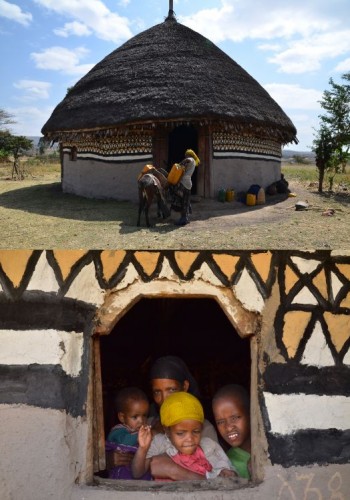THE EXHIBITION
ALONG THE SHORES OF THE LAKES ABBAYA AND CHAMO
 Laying in a valley overlooked to the west by the Guge Mountains, lakes Abbaya - which the Italians called Lake Margherita in honour of their Queen - and Chamo form a small inland sea (1,160 and 350 sq. km respectively) dominated to the south by a narrow plateau. On this promontory, known as the “Bridge of Paradise”, is located the town of Arba Minch which separates Abbaya from Lake Chamo and gives access to the 700 sq. km of the Nech Sark National Park.
Laying in a valley overlooked to the west by the Guge Mountains, lakes Abbaya - which the Italians called Lake Margherita in honour of their Queen - and Chamo form a small inland sea (1,160 and 350 sq. km respectively) dominated to the south by a narrow plateau. On this promontory, known as the “Bridge of Paradise”, is located the town of Arba Minch which separates Abbaya from Lake Chamo and gives access to the 700 sq. km of the Nech Sark National Park.
Rich in fishes and endemic birds, and inhabited by hippos and big crocodiles, Lake Abbayya receives the water of the Bilate river, which runs down from the Gurage Mountains, and enriches it with colloids from the thermal springs along its banks. Chamo receives a perennial refilling from the Kulfo river and also takes water overflowing from Lake Abbaya and hence, acts as a terminal lake.
Farmers from the surrounding mountains and from the Dorze settlement, relay on the lakes by working in the fish canning plant and in the crocodile farm.
These people are also known for their intensive exploitation of enset (Ensete ventricosum), a staple food crop in Ethiopia’s southern and south-western highlands. Commonly known as “false banana” as the plant resembles the banana tree but does not produce edible fruits, enset is a quite flexible plant, which can tolerate years of low rainfall but can also cope with heavy rains, hailstorms and frosts. It is usually cultivated in gardens which are situated next to the houses of individual families. Usually the gardens are enclosed to protect the plants against the damages from livestock and wild animals. Sometimes the plants stand in rows according to their age or type, sometimes are mixed.
Although there are indications that enset was already known in ancient Egypt, its actual place of origin has not yet been determined. Two theories are still debated. One indicates that the origin of enset lies in Asia, because all other species of Ensete are located there. The other sees the appearance of so many different varieties of Ensete in southern Ethiopia and the sophisticated systems of planting and processing in the same area as indications that it must be endemic to Ethiopia.
From the enset, local people make a thin bread, but also produce sacks, mates, ropes, bags, cords and building material from the stripping of its leafs. Special varieties are used for medical cures for broken bones and birth problems. These are only few examples of the many uses of enset; there is no part of this plant that can not be exploited in one way or another.



























